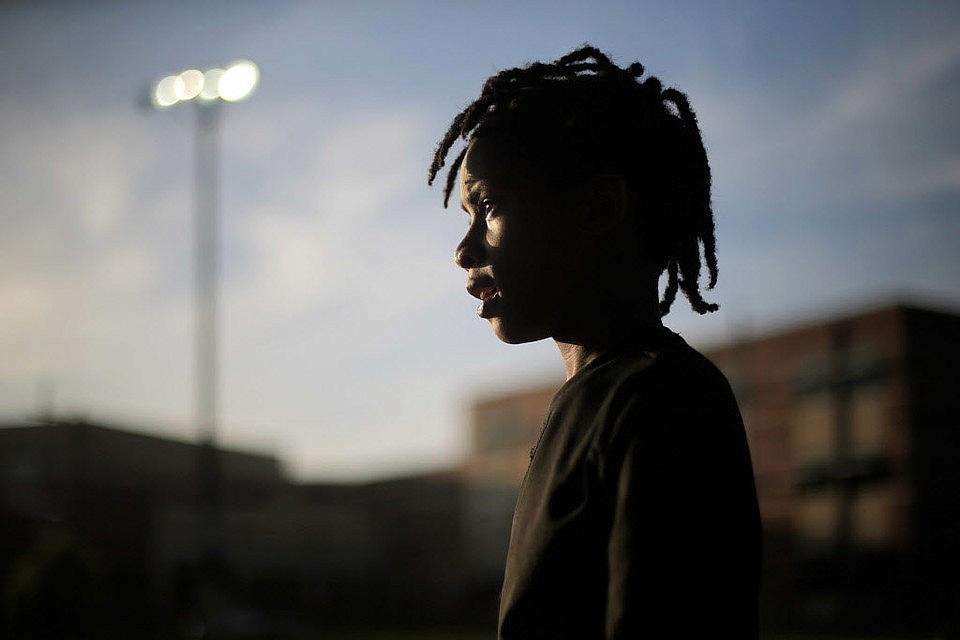The deepest wounds are those we don't see | Opinion
This article was produced as a project for the Dennis A. Hunt Fund for Health Journalism, a program of the USC Annenberg Center for Health Journalism.

Ji'Air Luckie, 10, arrives at A.L. Davis Park in Central City for football practice on Thursday, October 4, 2017. (Photo by Brett Duke, Nola.com | The Times-Picayune)
By Tim Morris, Columnist
Ji'Air Luckie was only 3 years old and his brother Jerone just 7 when they stumbled out of bed on the morning of June 11, 2011, to find their mother lying dead in a pool of blood on the kitchen floor of their Hollygrove home.
The coroner would determine that 24-year-old Cierra Luckie had been shot multiple times and died from a gunshot wound to the head, which explains why Ji'Air thought his mother was covered in "pink paint."
Police were summoned only after the boys had made their way outside and to a neighbor's house. "Come on, Ji'Air," Jerone told his little brother, "I think mommy's dead."
That Cierra Luckie's murder remains unsolved seven years later is just one of the many unresolved elements of a family tragedy that continues today. The energetic Jerone suddenly became withdrawn while Ji'Air, his grandmother said, "just couldn't function."
"He was always wanting to know where she was, and I guess he wasn't understanding, so he was acting out," Paulette Young said of the younger brother.
How could we expect anything else?
That the boys would display emotional problems in the face of such a profound event is hardly surprising, but it also is heartbreakingly common, according to reporting by Jonathan Bullington and Richard Webster in NOLA.com | The Times-Picayune's "Children of Central City." And too often, young victims are left to cope without access to counseling or, even worse, punished for behavior that they can barely understand, let alone control.
Children exposed to such events are deeply scarred, so deep that we ignore the wounds until they create some larger problem. And then we think it must be some weakness in them. Or we decide it must be poor parenting, a failure of "culture and values."
"As a society, we tend to blame the victim, right?" said Paulette Carter, president and CEO of the Children's Bureau of New Orleans, a nonprofit mental health agency. "So, like, you just weren't strong enough. Oh, those parents were just not good enough. He should be able to handle what he's dealt. What about, 'OK, you played football and you broke your leg. Were you just not physically strong enough? No.' It's the same thing with mental health. It's not that person's fault."
But a society that would bind a physical wound or set a broken bone, has not completely come to terms with the mental and spiritual trauma that is happening to hundreds of children every day.
A child who can't focus in the classroom is often diagnosed with attention deficit hyperactivity disorder and prescribed medicine that doesn't help, Webster and Bullington report. And when the behavior doesn't change, the student ends up in detention or is suspended from school in part of a downward spiral that cuts off development and opportunities.
In surveys of more than 300 students from Central City area public schools since 2016, one in five children have said they had witnessed a murder and more than half said someone close to them had been a victim of homicide, according to the Institute of Women and Ethnic Studies, a nonprofit public health organization who conducted the surveys.
Scientists and researchers have unsurprisingly found that children who grow up surrounded by crime and violence become conditioned to constantly respond in a defensive mode. They have difficulties with anger management, impulse control and the processing and retention of information, a disruption of pretty much everything needed to be successful or at least peacefully coexist in a school classroom.
Some, like Jerone, pull back into themselves. Others, like Ji'Air, act out. Neither is served by a system that ignores, misdiagnoses or punishes their problems.
The "Children of Central City" reporting points to something called trauma-informed learning as one promising approach to filling some of the holes. The structure includes training teachers to recognize signs of trauma, finding better ways to make students feel safe, and teaching them skills for coping. Discipline policies also take unseen factors into account.
Almost a dozen New Orleans schools are involved in using trauma-informed learning methods while others have started screening students for trauma and bringing in mental health counselors. That's a good start.
Through wars, catastrophes and natural disasters, we have painfully learned the long-term damage of what was once called "shell shock" and then "battle fatigue" and now Post-Traumatic Stress Disorder. The wounds are as real as anything caused by an M16 or a roadside bomb. We just don't see them as clearly.
No child should ever have to endure what Ji'Air and Jerone Luckie saw on that June morning seven years ago. But they did, and now they deserve a system that helps them heal and doesn't make them worse.
[This story was originally published by NOLA.com | The Times-Picayune.]

